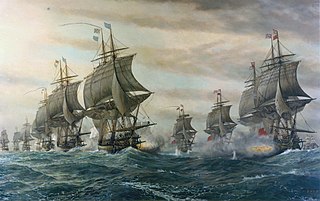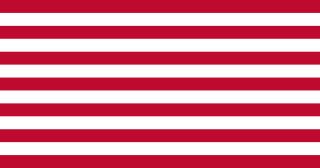Two ships of the United States Navy have been named De Grasse, in honor of Admiral Comte de Grasse of France.

The Battle of the Chesapeake, also known as the Battle of the Virginia Capes or simply the Battle of the Capes, was a crucial naval battle in the American Revolutionary War that took place near the mouth of the Chesapeake Bay on 5 September 1781. The combatants were a British fleet led by Rear Admiral Sir Thomas Graves and a French fleet led by Rear Admiral François Joseph Paul, the Comte de Grasse. The battle was strategically decisive, in that it prevented the Royal Navy from reinforcing or evacuating the besieged forces of Lieutenant General Lord Cornwallis at Yorktown, Virginia. The French were able to achieve control of the sea lanes against the British and provided the Franco-American army with siege artillery and French reinforcements. These proved decisive in the Siege of Yorktown, effectively securing independence for the Thirteen Colonies.
La Perouse may refer to:

François Joseph Paul, Comte de Grasse, Marquis of Grasse-Tilly SMOM was a career French officer who achieved the rank of admiral. He is best known for his command of the French fleet at the Battle of the Chesapeake in 1781 in the last year of the American Revolutionary War. It led directly to the British surrender at Yorktown and helped gain the rebels' victory.

The Battle of the Saintes, also known as the Battle of Dominica, was an important naval battle in the Caribbean between the British and the French that took place 9–12 April 1782. The British victory was considered their greatest over the French during the American Revolutionary War.

The Continental Navy was the navy of the United States during the American Revolutionary War, and was founded October 13, 1775. The fleet cumulatively became relatively substantial through the efforts of the Continental Navy's patron John Adams and vigorous Congressional support in the face of stiff opposition, when considering the limitations imposed upon the Patriot supply pool.

USS Comte de Grasse (DD-974), named for Admiral Francois-Joseph Paul, Comte de Grasse (1722–1788), was a Spruance-class destroyer built by the Ingalls Shipbuilding Division of Litton Industries at Pascagoula, Mississippi. She was laid down 4 April 1975, launched 26 March 1976 and commissioned 5 August 1978. She was christened 21 May 1976 by sponsor Madame Anne-Aymone Sauvage de Brantes, wife of the then-President of France, Valéry Giscard d'Estaing.

The American Revolutionary War saw a series battles involving naval forces of the British Royal Navy and the Continental Navy from 1775, and of the French Navy from 1778 onwards. Although the British enjoyed more numerical victories, these battles culminated in the surrender of the British Army force of Lieutenant-General Earl Charles Cornwallis, an event that led directly to the beginning of serious peace negotiations and the eventual end of the war. From the start of the hostilities, the British North American station under Vice-Admiral Samuel Graves blockaded the major colonial ports and carried raids against patriot communities. Colonial forces could do little to stop these developments due to British naval supremacy. In 1777, colonial privateers made raids into British waters capturing merchant ships, which they took into French and Spanish ports, although both were officially neutral. Seeking to challenge Britain, France signed two treaties with America in February 1778, but stopped short of declaring war on Britain. The risk of a French invasion forced the British to concentrate its forces in the English Channel, leaving its forces in North America vulnerable to attacks.
De Grasse may refer to:

The Battle of Saint Kitts, also known as the Battle of Frigate Bay, was a naval battle fought on 25 and 26 January 1782 during the American Revolutionary War between a British fleet under Rear Admiral Sir Samuel Hood and a larger French fleet under the Comte de Grasse.
De Grasse was an anti-aircraft cruiser of the French Navy. She was the first French vessel named in honour of François Joseph Paul, marquis de Grasse Tilly, comte de Grasse. From 1965 to 1971, she was involved in the nuclear test campaigns in the Pacific.

Ville de Paris was a large three-decker French ship of the line that became famous as the flagship of De Grasse during the American Revolutionary War.

USS De Grasse (AP-164/AK-223), originally SS Nathaniel J. Wyeth, was a Crater-class cargo ship active with the United States Navy during World War II. It was the second ship of the Navy to bear the name De Grasse, named after French Admiral François Joseph Paul de Grasse.

Alexandre Francois Auguste de Grasse, known as Auguste de Grasse and Comte de Grasse-Tilly, was a French career army officer. He was assigned to the French colony of Saint-Domingue in 1789, where he married in Cap Français, and acquired a plantation and 200 slaves before the Haitian Revolution. Following the Royal Navy's defeat of the French fleet in Saint-Domingue in 1793, de Grasse was allowed to resign his commission and leave with his family and in-laws for Charleston, South Carolina.
Bougainville may refer to:

Louis-Philippe de Rigaud, Marquis de Vaudreuil was second in command of the French squadron off America during the American Revolutionary War.
Three ships of the French Navy have borne the name De Grasse in honour of François Joseph Paul de Grasse:

USS De Grasse (ID-1217) was the projected name for an armed yacht that the United States Navy acquired for service as a patrol vessel in 1918 but, according to some sources, never commissioned, although other sources claim she saw brief naval service in 1918. In World War II, she was reacquired and served as YP-506. The yacht's official number was registered under the name Fleet as of 1959, fate unknown.
A Naval Registry Identification Number is a unique identifier that the U.S. Navy used for privately owned and naval vessels in the first half of the 20th century.

The Anglo-French War, also known as the War of 1778 or the Bourbon War in Britain, was a military conflict fought between France and Great Britain, sometimes with their respective allies, between 1778 and 1783. As a consequence, Great Britain was forced to divert resources used to fight the war in North America to theatres in Europe, India and the West Indies, and to rely on what turned out to be the chimera of Loyalist support in its North American operations. From 1778 to 1783, with or without their allies, France and Britain fought over dominance in the English Channel, the Mediterranean, the Indian Ocean and the Caribbean.